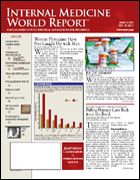Topical Antifungals Effective for Intertrigo
WASHINGTON, DC—Topical antifungals with antiinflammatory and antibacterial properties may minimize the need for topical steroids in patients with common chronic conditions such as intertrigo, reported Boni E. Elewski, MD, at the American Academy of Dermatology annual meeting.
Intertrigo is an inflammation of opposing skin surfaces and typically occurs in the groin, axillae, and inframammary regions. However, it may also affect interdigital spaces, perineal areas, and skin folds of the eyelids, neck, and abdomen.
It is most common in patients with diabetes or who are obese and are exposed to high heat and humidity. Other predisposing factors include urinary/fecal incontinence, hyperhidrosis, malnutrition, and poor hygiene.
Intertrigo begins with mild erythema that can progress to intense inflammation and itching, with oozing, crusting, fissures, maceration, and erosions. Patients usually complain of burning, itching, and tenderness or pain, said Dr Elewski, of the Department of Dermatology at the University of Alabama, Birmingham.
The condition is often confused with contact dermatitis, psoriasis vulgaris inversa, and Hailey-Hailey disease, thus correct diagnosis is important. “Of particular concern when a patient presents with intertrigo is the potential presence of a secondary skin infection with fungi and/or bacteria, because the moist, damaged skin is a good breeding ground for microorganisms,” she said. “Highly prominent inflammation is frequently a sign of secondary infection.”
Staphylococcus aureus
Pseudomonas aeruginosa
Proteus mirabilis
Proteus vulgaris
Candida
Malassezia
, with or without group A streptococcus, , , and are common bacterial infections associated with intertrigo. Although the most frequently found fungal infection is , dermatophyte infections associated with species have also been found, often in interdigital areas.
The management for mild intertrigo includes:
• Talc or cornstarch to absorb moisture
• Barrier creams, such as zinc paste or petroleum jelly to keep the area dry
• Over-the-counter antibacterial soaps containing triclosan to minimize inflammation
• Topical steroids are often used to treat inflammation and itching, but cannot be used for secondary infection.
Topical antifungals that also have antibacterial, antiinflammatory, and anti-itch properties are most beneficial for chronic intertrigo, Dr Elewski said.
Candida
Malassezia
Sertaconazole nitrate (Ertaczo), ciclopirox (Loprox), and naftifine (Naftin) are effective against dermatophytes. Sertaconazole and ciclopirox are also indicated for and infections.
Arch Dermatol Res
All 3 agents have antiinflammatory properties, but a recent study showed that only sertaconazole nitrate reduces cytokine release and inhibits contact hypersensitivity and scratching (. 2006; 298: 191-199).
Sertaconazole nitrate also demonstrated greater antiinflammatory action than butoconazole (Gynazole-1), ciclopirox, olamine, fluconazole (Diflucan), miconazole nitrate (eg, Micatin, Neosporin AF), terconazole (Terazol 3), tioconazole (Monistat 1), or ketoconazole (Nizoral).
Dr Elewski said that although ciclopirox, naftifine, and sertaconazole nitrate all have antibacterial qualities, sertaconazole has broad-spectrum antibiotic activity, including against Gram-positive cocci. “These properties contribute to the usefulness of sertaconazole nitrate in the treatment of intertrigo,” she said.
Treatment for intertrigo with secondary infection that does not respond to topical therapy requires the addition of an oral antifungal or oral antibiotic. Disease complicated by erythrasma is best treated with topical (Emgel) or oral erythromycin (E.E.S. 400), Dr Elewski said.
Key points
• Intertrigo affects diabetic and obese patients exposed to high heat and humidity.
• Differential diagnosis includes contact dermatitis, psoriasis vulgaris inversa, and Hailey- Hailey disease.
• Secondary skin infections are of particular concern in patients with intertrigo.
• Topical antifungal agents with antiinflammatory and antibacterial properties may minimize the need for topical steroids.
